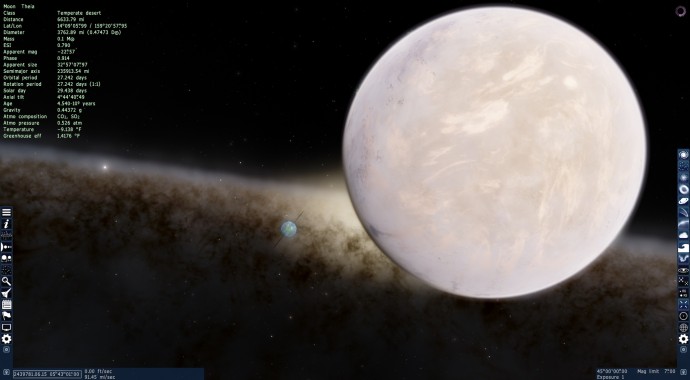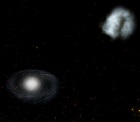|
Science and Astronomy Questions
|
|
| steeljaw354 | Date: Sunday, 09.10.2016, 00:32 | Message # 826 |
 World Builder
Group: Users
 Pirate
Pirate
Messages: 862
Status: Offline
| Watsisname, Why would it be smaller? Can you make this in Space Engine?
Edited by steeljaw354 - Sunday, 09.10.2016, 00:45 |
| |
| |
| Watsisname | Date: Sunday, 09.10.2016, 02:15 | Message # 827 |
 Galaxy Architect
Group: Global Moderators
 United States
United States
Messages: 2613
Status: Offline
| I was going by the properties of the moon you showed, which is smaller and denser. It doesn't have to be that way. If you are looking at a scenario where Theia, instead of impacting the Earth to form the Moon, settles into orbit to become a moon itself, then that moon would be much larger and more massive -- something like 10% of Earth's mass and half the diameter of Earth. It would raise larger tides, be bigger on the sky and provide more light. It would still become tidally locked very quickly. But the exact numbers depend on exactly what Theia was, and this varies across different models.
This can be made in Space Engine. See the tutorial for how to make a planet. 

|
| |
| |
| steeljaw354 | Date: Sunday, 09.10.2016, 02:42 | Message # 828 |
 World Builder
Group: Users
 Pirate
Pirate
Messages: 862
Status: Offline
| Watsisname, I just made it. The Barycenter and orbital period is probably dead wrong. What would it be like to have Theia as a moon?

Edited by steeljaw354 - Sunday, 09.10.2016, 02:42 |
| |
| |
| Watsisname | Date: Sunday, 09.10.2016, 07:23 | Message # 829 |
 Galaxy Architect
Group: Global Moderators
 United States
United States
Messages: 2613
Status: Offline
| The tides would be big: five or six times larger than the tidal change now.
The moon would be about 75% larger on the sky and provide three times as much light, assuming the same albedo.
The barycenter would be well outside the Earth: about 21,400 miles from the center and 17,500 miles above the surface.

|
| |
| |
| steeljaw354 | Date: Sunday, 09.10.2016, 14:43 | Message # 830 |
 World Builder
Group: Users
 Pirate
Pirate
Messages: 862
Status: Offline
| Watsisname, Would Earth and Theia tidally lock to eachother like Pluto and Charon?
|
| |
| |
| Watsisname | Date: Sunday, 09.10.2016, 22:05 | Message # 831 |
 Galaxy Architect
Group: Global Moderators
 United States
United States
Messages: 2613
Status: Offline
| Yes, and fairly quickly (on geologic timescales). If we set them at the current Earth-moon distance and let them both start with a rotation period of 12 hours, then Theia would become tidally locked in a few million years, and Earth would become locked in a few hundred million years.

|
| |
| |
| steeljaw354 | Date: Sunday, 09.10.2016, 22:28 | Message # 832 |
 World Builder
Group: Users
 Pirate
Pirate
Messages: 862
Status: Offline
| Watsisname, Interesting! Could life possibly form on both worlds? Would Theia stay in it's current orbit or will it move out or in?
|
| |
| |
| Watsisname | Date: Monday, 10.10.2016, 04:48 | Message # 833 |
 Galaxy Architect
Group: Global Moderators
 United States
United States
Messages: 2613
Status: Offline
| I don't know offhand any reason why life could not form on either world.  Although, like Mars, Theia might be too small to remain habitable for as long as Earth. It might not retain a thick atmosphere for very long, especially if large impacts blow it off. Although, like Mars, Theia might be too small to remain habitable for as long as Earth. It might not retain a thick atmosphere for very long, especially if large impacts blow it off.
How their orbits evolve depends on the initial spin/orbit rate and direction. Suppose that, like in the present Earth-moon system, Theia orbits in the same direction that Earth spins, but the orbital period is longer. This means it lags behind the tidal bulge that it raises on the Earth (since Earth's rotation drags that bulge ahead), so the bulge pulls the moon forward and accelerates it, giving it more orbital energy and expanding its orbit outward. This expansion continues until the bodies become synchronously locked.
But what if Theia were to orbit retrograde -- opposite Earth's spin? Then the bulge raised on the Earth will always be pulling Theia backward, sapping its orbital energy. It will migrate inward.

|
| |
| |
| quarior14 | Date: Monday, 10.10.2016, 16:51 | Message # 834 |
 World Builder
Group: Users
 Pirate
Pirate
Messages: 649
Status: Offline
| How to convert solar day to sidereal day (rotation period) ?
It is : Tsolar*(Ysolar/Ysidereal) (with Hsolar : Time solar (3600 s = 1 h) in hours, Ysolar : Year solar in days, Y[sub]sidereal : Years sideral in days, one day = time solar) ?
Because I tried that to update the planet Thalassa but Space Engine, it's not the same solar day.
Here my code and calculs on comment :
Code //Thalassa
Planet "Thalassa 1"
{
ParentBody "Thalassa system"
Class "Terra"
Mass 1.285428027
Radius 7015.9507 //hypothetic
RotationPeriod 29.56955461 //h = (29.4325*3600)*(313.966913/312.5116793) = 106450.3966 s (Solar day : 29.4325 h)
Gravity 1.06 //g = 10.3986 m/s² = 9.81*(1+(6/100))
Obliquity 5.71429 //hypothetic
Life
{
Class "Organic"
Type "Multicellular"
Biome "Marine/Terrestrial"
Panspermia false
}
Surface
{
SurfStyle 0.520806
OceanStyle 0.149282
Randomize (1.079, -0.889, 0.190)
colorDistMagn 0.0415044
colorDistFreq 697.054
detailScale 18045.4
colorConversion true
drivenDarkening -1
seaLevel 0.803431
snowLevel 1
tropicLatitude 0.10789
icecapLatitude 1
icecapHeight 1
climatePole 0.9375
climateTropic 0.353893
climateEquator 0.6875
heightTempGrad 0.583607
tropicWidth 0.0817879
mainFreq 0.584501
venusFreq 1
venusMagn 0
mareFreq 0.372759
mareDensity 0.0714286
terraceProb 0.319919
erosion 0
montesMagn 0.205713
montesFreq 259.412
montesSpiky 0.949549
montesFraction 0.485357
dunesMagn 0.0601864
dunesFreq 42.9586
dunesFraction 0.0593326
hillsMagn 0.0965508
hillsFreq 583.213
hillsFraction 0.891151
hills2Fraction 0.581915
riversMagn 66.8105
riversFreq 3.97417
riversSin 7.73035
riversOctaves 0
canyonsMagn 0.0339486
canyonsFreq 100
canyonFraction 0.520806
cracksMagn 0.130161
cracksFreq 0.824795
cracksOctaves 1
craterMagn 0.032052
craterFreq 59.6143
craterDensity 0
craterOctaves 0
craterRayedFactor 0
volcanoMagn 0.618842
volcanoFreq 0.781987
volcanoDensity 0.103175
volcanoOctaves 1
volcanoActivity 1.33333
volcanoFlows 0.00793651
volcanoRadius 0.544894
volcanoTemp 1761.9
lavaCoverTidal 0
lavaCoverSun 0
lavaCoverYoung 0
stripeZones 1.74933
stripeFluct 0
stripeTwist 0
cycloneMagn 2.64312
cycloneFreq 0.972265
cycloneDensity 0.322386
cycloneOctaves 4
colorSea (0.040, 0.100, 0.200, 1.000)
colorShelf (0.150, 0.480, 0.460, 1.000)
colorBeach (0.400, 0.330, 0.280, 0.000)
colorDesert (0.260, 0.240, 0.220, 0.000)
colorLowland (0.500, 0.420, 0.350, 0.000)
colorUpland (0.240, 0.210, 0.210, 0.000)
colorRock (0.220, 0.210, 0.210, 0.000)
colorSnow (1.000, 1.000, 1.000, 1.308)
colorLowPlants (0.100, 0.160, 0.070, 0.000)
colorUpPlants (0.090, 0.110, 0.040, 0.000)
BumpHeight 76.9841
BumpOffset 61.8515
DiffMapAlpha "Water"
SpecBrightWater 0.65
SpecBrightIce 0.85
SpecularPower 55
Hapke 0
SpotBright 4
SpotWidth 0.05
DayAmbient 0.07
}
Ocean
{
Height 61.8515
}
Atmosphere
{
Greenhouse 4.51 // degrees K
Pressure 1.21 // atm
Density 1.21 // kg/m^3
Model "Earth"
Composition // values in percent
{
N2 77.7729
O2 20.8625
Ar 0.9303
H2O 0.4000
CO2 0.0398
}
}
NoRings true
Orbit
{
RefPlane "Equator"
Period 1.052165173 //years (Sidereal year : (1.052165173 years = ((29.4325*313.1561)/24)/365 => Solar year : (((365*(1+(5/100)))*24)/29.4325 = 312.5116793 days)
Inclination 0.74
}
}
Unless I am mistaken to convert the sidereal year to solar year.
Information for Thalassa :
- Solar day : 29.432 h
- Sidereal year : 313.1561 solar day
- Gravity : 1.06 g = 10.3986 m/s²
Thanks in advance !
Quarior
Edited by quarior14 - Monday, 10.10.2016, 16:52 |
| |
| |
| Watsisname | Date: Monday, 10.10.2016, 18:24 | Message # 835 |
 Galaxy Architect
Group: Global Moderators
 United States
United States
Messages: 2613
Status: Offline
| 1/Psidereal = 1/Psolar + 1/Porbital
Change to a minus sign if it is a retrograde rotating planet.
To derive, notice that in one solar day the planet moves along its orbit by an angle equal to its orbital angular frequency times the length of solar day. During that same period of time, it rotates about its axis by one full rotation relative to the stars, plus an additional bit of angle which is equal to the angle it moved along its orbit (so that the same point on the planet faces the sun again). That full angle of rotation is equal to its angular rotation frequency (relative to the stars) times the length of solar day. Relate these and convert angular frequencies to periods to find the sidereal period.

|
| |
| |
| quarior14 | Date: Monday, 10.10.2016, 18:59 | Message # 836 |
 World Builder
Group: Users
 Pirate
Pirate
Messages: 649
Status: Offline
| Quote Watsisname (  ) 1/Psidereal = 1/Psolar + 1/Porbital
Ah, already found a solution and a problem :
For me, I thought Psidereal = Porbital, a big mistake I see, and I do'nt know Psolar and Porbital, I just Psidereal.
Quote Watsisname (  ) Change to a minus sign if it is a retrograde rotating planet.
Ah, to take information but in principle, it rotates in the direction prograde since it has no information in the book about it.
Quote Watsisname (  ) To derive, notice that in one solar day the planet moves along its orbit by an angle equal to its orbital angular frequency times the length of solar day. During that same period of time, it rotates about its axis by one full rotation relative to the stars, plus an additional bit of angle which is equal to the angle it moved along its orbit (so that the same point on the planet faces the sun again). That full angle of rotation is equal to its angular rotation frequency (relative to the stars) times the length of solar day. Relate these and convert angular frequencies to periods to find the sidereal period.
How do you that I find this ? We can not find other means without know the angle ?
Quarior
|
| |
| |
| Watsisname | Date: Monday, 10.10.2016, 20:02 | Message # 837 |
 Galaxy Architect
Group: Global Moderators
 United States
United States
Messages: 2613
Status: Offline
| Quote quarior14 (  ) How do you that I find this ? We can not find other means without know the angle ?
Oh, you don't need to. I was describing how the formula itself was found -- that process is all symbolic, no numbers. To use the formula, you only need to know two of the three periods.
You already know the sideral period, and you can find the orbital period by Kepler's Third Law: the square of orbital period equals 4pi2/GM times the cube of the semi-major axis:

where "T" is orbital period and "a" is semimajor axis. "M" is the mass of the star it orbits and "G" is the gravitational constant.
Then once you have the orbital and sidereal periods you can find the solar period with the formula.
Quote quarior14 (  ) Ah, to take information but in principle, it rotates in the direction prograde since it has no information in the book about it.
Yeah, most planets rotate prograde. 

|
| |
| |
| spacer | Date: Monday, 10.10.2016, 20:27 | Message # 838 |
 Star Engineer
Group: Users
 Israel
Israel
Messages: 1258
Status: Offline
| 
try to think about that and maybe solve it Watsisname,  
"we began as wanderers, and we are wanderers still"
-carl sagan
-space engine photographer
|
| |
| |
| quarior14 | Date: Monday, 10.10.2016, 20:47 | Message # 839 |
 World Builder
Group: Users
 Pirate
Pirate
Messages: 649
Status: Offline
| ]Watsisname, thanks, but I don't have semimajor axis (it is AU ?), I juste sidereal periods, so I have Psidereal = 1.052165173 years = 313.1561 solar days = 9216.96691325 hours
=> 1/Psidereal = 1/Psolar + 1/Porbital <=> 1/Psolar = 1/9216.96691325 - 1/((4π2a3)/6.6738480*10-11*0.8*1.9891*1030))
Edit : I found this for Porbital :  (Source : Wikipedia) (Source : Wikipedia)
Edit 2 : I'm stupid...
1/Porbital = 1/Psidereal - 1/Psolar <=> 1/Porbital = 1/1.052165173 - 1/1.0500000001138413242009132420091 = -0,0019598343188704316143210359517 years
Porbital = 1/(-0,0019598343188704316143210359517) = -510,24721343606184076731659026361 years
I mistake or it is retrograde ?
Quarior
Edited by quarior14 - Monday, 10.10.2016, 23:11 |
| |
| |
| Watsisname | Date: Monday, 10.10.2016, 20:47 | Message # 840 |
 Galaxy Architect
Group: Global Moderators
 United States
United States
Messages: 2613
Status: Offline
| spacer:
LOL. Basically this is like saying "Let's consider a scenario which requires disregarding our understanding of physics. What does our understanding of physics imply about what will happen when we do this?" 

|
| |
| |